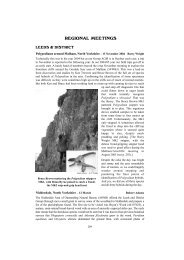Full Contents as pdf File - Natural History Museum
Full Contents as pdf File - Natural History Museum
Full Contents as pdf File - Natural History Museum
Create successful ePaper yourself
Turn your PDF publications into a flip-book with our unique Google optimized e-Paper software.
Hoh River Rain Forest (Wednesday) Jack Schieber<br />
The day started at 5a.m. for a group of four carried by Nils Sundquist in his car on a side<br />
trip to Hurricane Ridge, a high, more open part of the Olympic National Park, accessible<br />
from the Port Angeles area where we had stayed the night. There were no new fern species on<br />
the drive up and none were seen at the end of the road. Reportedly, there is a Polystichum<br />
kruckebergii 7.6 miles out on a trail – too far to go in the time permitted. Our visitors did<br />
report seeing a deer, a chipmunk and a marmot. New plants found included Menzies’ larkspur<br />
(Delphinium menziesii) and white-flowered rhododendron (Rhododendron albiflorum).<br />
As we drove in on the approach road to the Hoh Rain Forest, I w<strong>as</strong> struck by the view of forest<br />
floor covered by ferns and I overheard someone on the bus exclaim, ‘impressive’. People who<br />
are not fernophiles often confuse quantity with diversity, recommending <strong>as</strong> great a location<br />
that turns out to have only one fern species covering the ground. Some of us want localities<br />
where we can find many species and hybrid ferns. But <strong>as</strong> we rolled along in the bus I mused<br />
and became aware of the beauty of this woodland filled with sword fern (Polystichum<br />
munitum), a struggler in my e<strong>as</strong>tern garden but seen everywhere on this foray. There is beauty<br />
in abundance and lushness just <strong>as</strong> there is in the plant itself. When I travelled in the UK, I saw<br />
everywhere that pestilent weed, bracken, and it is obviously a problem for farmers and other<br />
plants. But I make the challenge – close off the mind and let the eye hold sway – see that<br />
hillside covered with bracken – see the plant and its form – and be immersed in beauty.<br />
The Hoh River Valley rainfall ranges from 140 to 167 inches (that’s 12 to 14 feet) of rain<br />
per year <strong>as</strong> the Olympic Mountains disturb the moisture-laden winds from the Pacific<br />
Ocean; Port Angeles on the leeward side receives about 20 inches per year. The trees in the<br />
valley were old and huge and festooned with moss, creating an ethereal understorey that<br />
could be inhabited by Hobbits. The dominant trees, some reaching 300 feet in height, were<br />
sitka spruce, western hemlock and western red cedar. Big-leaf maple, vine maple, red alder<br />
and black cottonwood were the predominant deciduous trees. The Olympic National Park<br />
lists five trees recognised by American Forests <strong>as</strong> the largest living specimens of their<br />
species: Al<strong>as</strong>ka cedar (Chamaecyparis nootkatensis), Pacific silver fir (Abies amabilis),<br />
subalpine fir (Abies l<strong>as</strong>iocarpa var. l<strong>as</strong>iocarpa), Engelmann spruce (Picea engelmannii)<br />
and western red cedar (Thuja plicata). The presence of nurse trees or nurse logs is a unique<br />
characteristic of this rain forest. The trunks of trees, long-since fallen, hold moisture in the<br />
process of decay and act <strong>as</strong> a nursery for tree and plant seedlings. And so we saw a line of<br />
trees growing along 100 feet of log having roots distorted to reach around the log to the<br />
earth beneath. It w<strong>as</strong> not unusual to see a tree with roots circling a kind of hole where the<br />
nurse log had been and had rotted away.<br />
From the Hoh Visitor Centre a Ranger guided us over the wood walkways that carried us<br />
among the flora and fauna. We noted all of the eight fern species listed in the Park handout,<br />
‘Ferns of the Hoh’: Polystichum munitum, Polypodium glycyrrhiza, Blechnum spicant,<br />
Athyrium filix-femina var. cyclosorum, Pteridium aquilinum var. pubescens, Adiantum<br />
aleuticum, Gymnocarpium dryopteris and Dryopteris expansa. By our own expertise, we<br />
identified Equisetum telmateia, E. arvense and Selaginella oregana. The oak fern, which<br />
w<strong>as</strong> everywhere on the ground, w<strong>as</strong> the largest I’d ever seen.<br />
Leaving Hoh and travelling south along the co<strong>as</strong>t we first stopped at Ruby Beach where we<br />
had a lovely walk through the woods above the headland. Here we first saw co<strong>as</strong>t polypody<br />
(Polypodium scouleri), and large burls on spruce trees.<br />
Our next stop w<strong>as</strong> ‘Beach four’, where we were greeted by a jumble of huge drift logs along the<br />
shoreline and huge impressive rock formations along the beach among which were scattered<br />
tidal pools. Down on the beach a Park Ranger gave us a short lecture on tidal pools and the<br />
peculiarities of the barnacles, sea anemones and hermit crabs that inhabit them. A starfish w<strong>as</strong><br />
shown to stick to the short hairs of my head and in pulling it away I lost a few more to the<br />
106

















